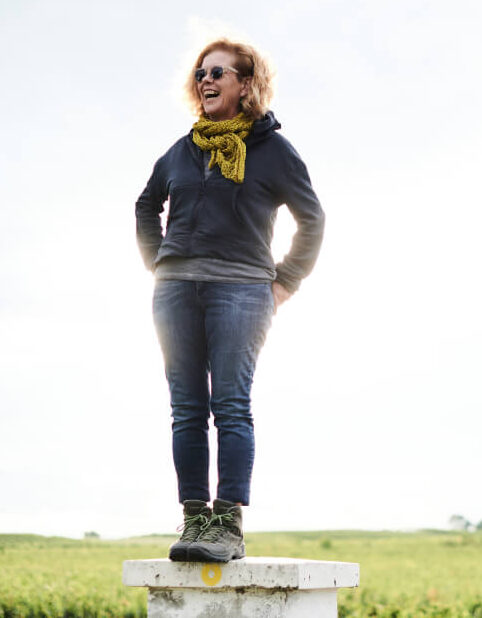- Chateau Puy Servain Terrement Montravel Rouge 2017 $19
- Niepoort, Douro “Twisted” Branco 2021, $20
- Heidi Schroek & Sohne “Tour de Rose” 2021, $19
- Dashe Cellars Red Blend “Delta Reds”, $22
- Les Vignerons du Quercy Manifeste Le BonTemps Coteaux du Quercy 2019 $22
- La Capranera Falanghina 2021, (Organic/Biodynamc) $22
———————– (The 3-bottle Club Option) ———————–
1. Chateau Puy Servain Terrement Montravel Rouge 2017 $19
The Wine
The first wine we’ve selected for this month is a blend dominated by Merlot, with Cabernet Franc playing the supporting role. Though this is the classic Right Bank blend, the wine hails from due east of the city of Bordeaux, still on the Dordogne river but the next appellation over.
The wine makes a firm opening statement with deep, opaque purple in the glass and intense aromas. It is big but not brawny on the palate, with aromas and flavors of plum, cherry, and bramble berries and a wonderfully complex minerality from the vineyard’s chalky limestone soils. It finishes with silky tannins from extended skin contact and 12 months in oak (30% new).
The Winery
Chateau Puy-Servain is located high in the Montravel and Bergerac appellations of France. The estate takes its name, Puy-Servain, from the name of the hilltop of Puy-Servain, which translates literally as ‘windy summit’.
The winery is owned by Daniel Hecquet, one of the region’s best and most innovative winemakers and a sought-after consultant. An accomplished oenologist, Daniel honed his craft while working at famed Chateau d’Yquem and Chateau Figeac in Bordeaux. But he comes by his stellar reputation with a bit of a leg up from his family – he was raised at the estate and is now the third generation of his family to own Puy-Servain.
And what an estate – consisting of 113 acres of vines spread across five sub-regions, all farmed in compliance with the winery’s commitment to sustainable agriculture. Like much southwestern France, the climate here is influenced by the Dordogne River, which has also contributed sought-after gravel and limestone vineyard soils that make these wines more interesting than their price would indicate.
2. Niepoort, Douro “Twisted” Branco 2021, $20
The Wine
Twisted Branco (Portuguese for “White”) is a white wine from the Douro, created specifically for the American market. It is an enticing blend of Portuguese grapes familiar to very few domestic wine lovers – Rabigato, Códega do Larinho, Gouveio, Dona Branca, Viosinho, Bical and more! The wine is fun not only for its pleasant flavors and aromas, but also for the story depicted on the label by American animator Bill Plympton. The art depicts a cowboy and a horse toasting each other – a light-hearted play on the word Branco, which is pronounced exactly like our word ‘Bronco’.
I’ve tasted this wine over the course of four different vintages. While it varies according to the vagaries of each vintage, it is always a reliably crisp and refreshing wine – a great example of the Niepoort style: austere but with alluring mineral notes. As with many lighter style wines, it sees no oak, malolactic fermentation, fining or filtering.
This fresh white wine (12.4% ABV) shows herbaceous and citrusy notes and promises surprising ageing potential. Overall, a wine of great finesse and elegance, ending in an enticing, lingering and zippy finish.
The Winery
Talk about someone who became a successful winemaker with a little help from the family, the Niepoorts have been creating Port Wines since 1842. Dirk Niepoort helped the family branch out into the world of non-fortified wines with his family’s first property in the Douro in 1987. Four short years later, he launched a new era for his family with the creation of ‘Redoma Red’ in 1991.
More recently, Niepoort has taken on the challenge of interpreting other soils and climates of Portugal, acquiring two additional properties in Dão and Bairrada. Together with his original holdings, they create ‘the Niepoort Triangle’ – wines from three regions, each expressing Portugal’s unique terroirs: Schist (Douro), Limestone (Bairrada) and Granite (Dão).
3. Heidi Schroek & Sohne “Tour de Rose” 2021, $19
The Wine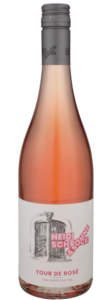
First, a word on spelling. As you know, we don’t use umlauts in the English language, nor do our keyboards easily adapt so we can type them when needed. I’m sure I could google it and find the keyboard shortcut, but there’s an easier way. Instead of typing SCHRÖCK, we can simply type Schroeck – same pronunciation, and acceptable to even strict Austrian linguists!
On to the matter at hand – this delicious wine. ‘Racy’ is the word that will come to mind. You know those blush wines described as “porch pounders”? This ain’t that.
Not that I wouldn’t drain a whole 12.5%-ABV-bottle on my porch. It’s just that, relative to the wines labeled as such, this wine has so much more mouth-watering acidity it acts like a strong spine on which Heidi & sons have hung the wine’s complex aromas and flavors (red berries, pink lady apples, floral notes) like ornaments on the branches of a Christmas tree. The wine gets added complexity from being fermented in multiple vessels – acacia, oak and stainless steel, before being racked, blended and left on the lees for 4 months.
This is one of the most versatile food wines you will ever separate from its cork! The wine is a mind-bending blend of grapes – Blaufränkisch, Zweigelt, Merlot, Cabernet Sauvignon, Pinot Noir, Syrah, Lagrein, Teroldego, Petit Verdot – all co-planted in a single block of the family vineyard on the Eastern edge of Austria, just South of Vienna.
The Winery
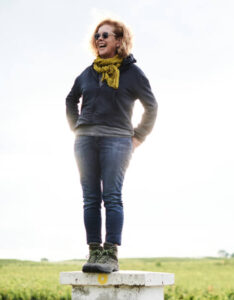
Heidi, right where she belongs. On a pedestal.
Heidi took over her family winery in 1983, and by 2003 had been awarded “Falstaff Vintner of the Year”. Winners of the Falstaff award breathe rarified air already, and Heidi even more so – being one of the first women winemakers to be so honored.
I first met Heidi some twenty (yikes! really?!) years ago when working with her importer. Over the course of several years of interactions with dozens of German and Austrian producers, Heidi earned the top spot as one of the most charming winemakers I’ve ever met. Always cheerful, tremendously talented, and serenely confident and humble all at once. I believe it’s impossible to have a bad time when Heidi is around. So I was quite thrilled when I learned she was now working with her two sons –
Her family has been engaged in the wine business for over 300 years, and now she’s passing the torch to her twin sons, Johannes and Georg, who, like their mother, continue to produce classic Ruster wines, while experimenting with other varieties and winemaking styles on the side. I hope this torch doesn’t pass any time soon, but it’s comforting to know the Schroeck wines will continue to be in good supply for at least one more generation.
———————– (the 6-bottle Option, all of above, plus…) ———————–
4. Dashe Cellars Red Blend “Delta Reds”, $22
The Wine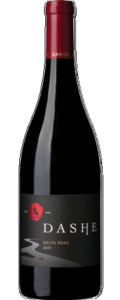
This wine announces itself by sliding up beside you and slapping you on the back as it says “at the end of this glass you may or may not like me, but you sure as hell won’t have any question about who or what I am!”
It introduces itself with a big nose-full of dried plums, black raspberry, all supporting enticing top notes of cranberry and pomegranate. But a fruit-dominated wine can be sexy at first and then grow quickly uninteresting – I call such wines the Bimbos of the wine world. This is not that!
Turn the conversation to deeper topics and this wine responds with black pepper, dark licorice/tar, and earth. Whether at the end of your first glass or the second bottle, you’ll walk away with a lingering memory of your new friend – a velvety, attractive wine made beautiful by its fruit flavors and interesting by its ability to hold a complex conversation.
Anyone living in the Bay Area has heard of “The Delta” – the confluence of rivers flowing west from the state’s Eastern mountains towards the Bay and out to the Pacific. It is sometimes known for its floating parties, but today our interest involves its rich agricultural history, providing a home to 100-year-old vines of Zinfandel, Carignane, and Mouvedre as well as newer plantings of interesting varietals like Teraldego, Tannat, Barbera, and Petite Sirah. And we all have Dashe Cellars to thank for harnessing the cool breezes and hot days of the area’s most interesting grapes to create this “Delta Reds” blend.
The Winery
Dashe Cellars is an urban winery that inhabits a large facility on what was once the Alameda Naval Air Station. I can’t think of a better use for that space.
The husband-and-wife team of Michael and Ann Dashe (Right) started Dashe Cellars in 1996, and have developed a devoted following among locals and visitors alike. But their grapes aren’t urban at all. In this case, they hail from Sonoma’s Dry Creek Valley (not so aptly named, during years when rainfall is heavy it would better be called “Flooded Creek Valley“… but I digress). Perhaps best known for its Zinfandel wines, Dry Creek Valley is also home to some of California’s best Rhone varietals.
5. Les Vignerons du Quercy ‘Manifeste Le Bon Temps’ Coteaux du Quercy 2019 $22
The Wine
“Manifeste le bon temps” – make the good times happen – and that pretty much sums up this wine in a nutshell.
Need I go on? Every word that follows will be superfluous, but if you insist… You sure i can’t get a hall pass?
OK, if you insist.
This is the top wine from the wienry’s oldest vineyards. Harvest is delayed to assure the full ripeness required for the intended style of this wine. The juice is left in contact with the skins for more than 5 weeks during which the color extraction occurs with minimal pump-overs, a wine-making choice intended to preserve the wine’s gentle side. Finally, the he wine is aged briefly in tanks and in bottle for a total of 2 years prior to release.
Tasting notes – You’ll find all the fruitiness and finesse of all the winery’s red grapes in this wine – a blend of Cabernet Franc, Tannat, Malbec and Merlot. Its complex nose features notes of jammy fruit that leads to a dense and silky mouthfeel. I think you’ll find this wine to be an ideal pairing for beef, roast duck / duck confit, pork tenderloin and uniquely enough, a dark chocolate dessert (‘hello my Valentine!”)
Drink now through 2029.
The Winery
It was in 1985 that the first stone of the Vignerons du Quercy cellar was laid and the first vintage bottled. And with that vintage, the first awards (Gold Medal in Paris, Toulouse, South-West, etc.)
Initial results were encouraging and reassuring for this small group of determined farmers, who chose to pool their grapes in their grower cooperative. Working together like this can be difficult, as not all grapes meet the group’s quality standards every year. It requires putting egos aside and placing the group ahead of the individual.
In this part of France, farms are small, so mixed farming is key. By avoiding a grape monoculture, they avoid many of the vie diseases and problems that come with dependence on a single crop. Could polyculture, the first precept of biodynamics, be the future of viticulture? It seems increasingly evident.
This wine is the story of a collective, a cooperative, of 24 men and women brought together over 288 acres of vines spread across the AOP Coteaux du Quercy terroirs.
6. La Capranera Falanghina 2021, (Organic/biodynamic) $22
The Wine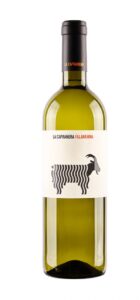
Tropical fruits meld with crsip citrus on top of a pine and mineral base that makes this wine alluring and memorable well beyond its price point and long into next week. The palate throws the taster a curve, showing apples and pears that weren’t evident on the nose.
Falanghina is an ancient Italian white grape, believed to be the grape that either was, or was the parent of, the Falernian (a spiced, oxidized wine I’m sure we’d find dreadful by today’s standards!). Ninety nine percent of the world’s supply of Falanghina is grown in Italy, and most of that can be found in the Campania region – if you think of Italy as a boot, Campania would be the shin – where it thrives in the fairly infertile volcanic soils around Mt Vesuvius.
Drink now through 2025.
The Winery
Owned by Giuseppe Pagano, this sprawling property covers 270 acres. And once again, the property’s layout has been informed by the wisdom of polyculture – inaddition to 58 acres of organic/biodynamic vineyards, Giuseppe also has a herd of buffalo for his Bufala Mozzarella, 24 acres of olive trees for his EVOO, a flock of laying chickens, bee hives for honey, a dairy and yogurt creamery and various fruit orchards and gardens for his line of jams and marmalades. Along with his proprietary brand of whole meal and whole grain pastas, visitors to Giuseppe’s agritursimo never have to worry about eating well!


